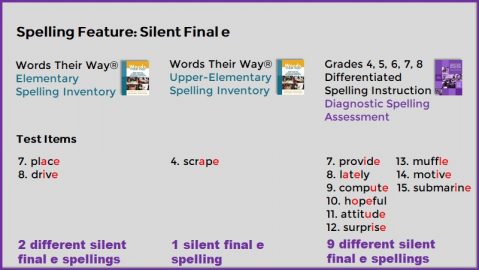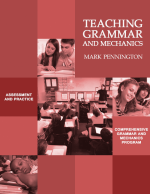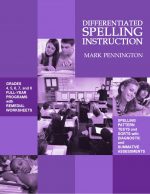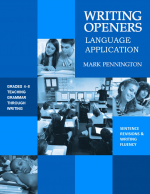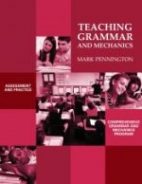Spelling Tests and Instruction
Years ago I attended a four-day training by Dr. Shane Templeton, an author of a new program titled Words Their Way®. Dr. Templeton drove down to Elk Grove to in-service our cadre of 18 reading specialists. An entertaining presenter, he demonstrated the theory of five developmental spelling stages and introduced the Qualitative Spelling Inventory (later reworked and published as the Primary Spelling Inventory, Elementary Spelling Inventory, and Upper-level Spelling Inventory.
From Dr. Templeton’s training, I developed numerous district and site level in-services for teachers interested in word study, primarily spelling. For each training, principals provided Words Their Way® for each teacher, and our district adopted the spelling inventory as one of our elementary literacy placement assessments. Teachers dutifully engaged their students in exploratory word sorts and other activities recommended for each spelling stage. After a two-year investment in the Words Their Way® approach, here’s what our reading specialist team and teachers found:
Virtually no gains on both standardized tests and our other writing, reading, fluency, spelling, syllabication, and phonics posttests. Our elementary students’ reading scores were mired in the 40th percentiles. The inductive Words Their Way® approach to word study and other similar approaches to spelling, phonics, and vocabulary acquisition were not paying off. Teachers rightfully complained that the Words Their Way® instructional activities took up inordinate amounts of their literacy block time.
Fortunately, our district chose to change direction and adopt a direct instruction, explicit and systematic phonics program: Open Court for kinder-third grade. Within two years our scores improved to the 70th percentiles. Grades 4-6 students improved as well upon later adoption of the program and because students coming out of primary had such a solid foundation. An interesting anecdotal sidebar: In our highly transient and growing district, our reading specialist team found that new transfer students in grades 4-8 were woefully unprepared for the rigors of multisyllabic expository text. As a result, our literacy leadership team created diagnostic assessments and instructional activities for site-level literacy intervention classes.
One of these diagnostic assessments, the Diagnostic Spelling Assessment, was my primary contribution. The test grew out of the Words Their Way® spelling inventories, which indicated a need for different levels of spelling instruction. However, unlike the inventories, we reading specialists and our district teachers wanted teachable data, not just placement test data. Rather than discover that a fourth grader was scoring in the “Within Word” developmental spelling stage, we wanted to know precisely which spelling patterns had and had not been mastered to target instruction for our grade level and reading intervention students, rather than spend inordinate amounts of class time with exploratory word study and word games.
My reading specialist colleagues were ruthless revisers. We argued over many test items, but finally achieved consensus on a comprehensive assessment that mirrored the Open Court phonics program sound-spellings and added the conventional spelling rules which applied to the “Syllable Juncture” and “Derivational” spelling stages of Words Their Way®. We field tested the Diagnostic Spelling Assessment in grades 4-8 and teachers found that this comprehensive assessment provided much more teachable data than did the old spelling inventories.
To compare the more popular Words Their Way® spelling inventories to the Diagnostic Spelling Assessment, I’ve put together a four-minute video https://www.youtube.com/watch?v=aczs81Jhcz8 to compare test items and determine which assessment provides the most teachable data. I’ve also included the Diagnostic Spelling Assessment (with audio file), recording matrices, and sample spelling worksheets as a free download in case the video convinces you to do so. Just click the link in the YouTube description.
Unfortunately, the Open Court® program, which did such an admirable job with decoding and comprehension had no systematic spelling instruction. As you know, decoding (phonics) is the one side of the words coin and encoding (spelling) is the other. Our spelling scores remained far below our phonics scores. Principals, who tend to always be about test results, demanded spelling curriculum. However, publishers remained reticent to invest monies and resources in outlier states, such as California, because just a few years back at the height of the whole language movement, State Superintendent of Instruction, Bill Honig, refused to adopt spelling workbooks for the state and directed principals to squash direct spelling instruction.
I was tasked by a school principal from the highest performing elementary school (out of 33) in our district to develop curriculum to “get my spelling scores up.” For that entire school year, two days a week, I continued to refine the Diagnostic Spelling Assessment and write targeted spelling pattern worksheets to correspond to each test item. Students benefited from my hyper-focus in the reading intervention class I taught after school and grade-level teachers snatched up my targeted worksheets to use in their classrooms. Yes, our spelling scores shot up through the roof on the spring standardized tests.
The next year I published (with district permission) my own spelling workbook for reading intervention. Over the next few years, I wrote five grade-level spelling programs (grades 4, 5, 6, 7, and 8), using the best of the Words Their Way® instructional components (word sorts, book searches, games, etc.), but using a much more efficient deductive approach. Each program retained the Diagnostic Spelling Assessment and the corresponding spelling pattern worksheets, each with a formative assessment, that teachers found so valuable to pinpoint spelling instruction. The result? The Grades 4-8 Differentiated Spelling Instruction programs, designed to help students catch up while they keep up with grade-level spelling instruction.




